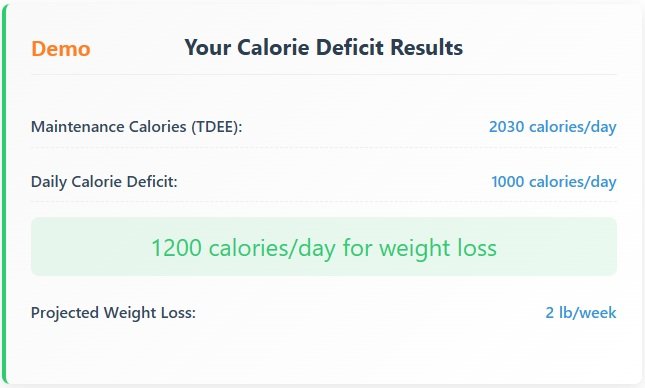
A calorie deficit occurs when you consume fewer calories than your body needs to maintain its current weight. This forces your body to use stored fat for energy, resulting in weight loss.
How the Calculator Works
This calculator estimates your Total Daily Energy Expenditure (TDEE) based on your personal information and activity level. It then subtracts calories based on your weight loss goal to determine your daily calorie target.
Safe Weight Loss
For healthy and sustainable weight loss:
- 0.5 lb/week: 250 calorie deficit per day - Slow but easiest to maintain
- 1 lb/week: 500 calorie deficit per day - Recommended balance
- 1.5 lb/week: 750 calorie deficit per day - More aggressive
- 2 lb/week: 1000 calorie deficit per day - Maximum recommended
Tips for Maintaining a Calorie Deficit
- Focus on nutrient-dense, high-volume foods that keep you full
- Track your food intake accurately using a food scale or app
- Combine diet with exercise for better results and health
- Be patient - sustainable weight loss takes time
- Adjust your calorie intake as you lose weight
What Is a Calorie Deficit?
Calorie deficit means that your body is burning more calories than you are consuming. In simple terms, if you are consuming 2200 calories per day but are only consuming 1800 calories, then your body is creating a deficit of 400 calories. This is called a caloric deficit.
For this deficit, the body uses stored fat to meet its energy needs, and that is why weight starts to decrease. The essence of this whole concept is — “You have to eat fewer calories than your body burns”.
Why Calorie Deficit Is Essential for Weight Loss
A calorie deficit to lose weight is the most important thing. This is a scientific rule, which is called energy balance. Body weight increases only when you are consuming more calories than you are consuming. This is called a "positive energy balance".
On the other hand, when you eat fewer calories but the body is burning more calories (such as for exercise, walking or metabolism), a negative energy balance is created, which results in weight loss.
The main goal is to create this balance between daily food intake and body needs. So if you ask, how to be in a calorie deficit or how to figure out calorie deficit, then the answer is one — you need to know how many calories your body is consuming every day, and how much you are eating.
How to Calculate Calorie Deficit for Weight Loss
The easiest and most effective way to calculate calorie deficit is to follow the steps below:
Know your Maintenance Calories (TDEE):
First, you need to know how many calories you are consuming every day without gaining or losing any weight. This is called TDEE (Total Daily Energy Expenditure). TDEE depends on your age, gender, height, weight, and daily activities.
Determine a safe deficit:
Generally, a deficit of 500 calories per day is safe and effective. If you follow this, you can lose about 0.5 kg of weight per week.
For example:
If your TDEE is 2200 calories, then eating 1700 calories per day will create a caloric deficit of 500 calories. This will be a completely safe way how to calculate calorie deficit for weight loss.
For your convenience, we have created a free calorie deficit calculator tool, so that you can easily find out the appropriate calorie deficit for you.
Use Our Calorie Deficit Calculator Tool
You can easily find out how much calorie deficit you need by using the calorie deficit calculator on this website.
What inputs to give:
Age
Gender
Height – supports both centimeters and feet + inches
Weight – supports kilograms and pounds
Activity Level
What output you will get:
Maintenance Calories (TDEE)
Recommended calorie deficit
Target Calories for weight loss
This calories deficit calculator will also help you accurately as a caloric deficit calculator.
How Many Calories Should I Eat to Lose Weight?
Many people ask the question — how many calories should I eat to lose weight? The answer depends on your current weight, age, physical activity and goals.
A safe and effective weight loss rate is 0.5 to 1 kg per week. For this, you need to create a deficit of 500 to 1000 calories per day.
Example:
If your TDEE is 2500 calories, then if you eat 2000 calories per day, you can lose about 0.5 kg of weight per week.
How many calories to lose weight or how many calories do I need – the answers to these questions depend on personal data, which you can determine for yourself with our calculator.
Tips to Stay in a Calorie Deficit Without Feeling Hungry
Many people think that calorie deficit means loss of appetite, weakness or energy. But that is not the case. By following the tips below, you can maintain a calorie deficit without feeling hungry.
- Eat protein-rich foods
Protein takes time to digest and keeps the stomach full for a long time. Eat fish, eggs, chicken, lentils, chickpeas regularly.
- Fiber and water
Eating fiber-rich foods such as vegetables, fruits and whole grains slows down digestion and reduces hunger. Drinking enough water can sometimes reduce hunger.
- Plan your meals
When you plan ahead of time what you will eat during the day, you will be less likely to overeat. Meal planning is the most effective way to stay in a deficit.
.png)